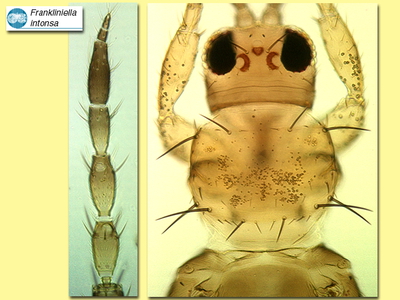Figures
Fig. 1 Antenna, head and pronotum
Fig. 2 Fore wing
Fig. 3 Meso- and metanotum
Fig. 4 Tergite VIII (female)
Fig. 5 Tergite V with ctenidium
Species
Frankliniella intonsa Trybom
Biology
A highly polyphagous flower-living species, that is sometimes a pest on stone fruit crops in Europe and of flower crops in Taiwan, and is also a vector of tospoviruses.
Distribution
Widespread across Europe to India, Thailand, Taiwan and Japan, and also found in the northwestern coastal region of North America.
Recognition
Body colour brown to yellowish brown, head and pronotum paler than abdomen; legs yellow with brown markings, major setae dark; antennal segments I & II, VI-VIII brown, III-V yellow with apex brown; forewing pale. Head with 3 pairs of ocellar setae, pair III on anterior margins of ocellar triangle; major postocular setae less than half as long as ocellar setae III. Antennae 8-segmented, III & IV with sense cone forked. Pronotum with 2 pairs of long setae on anterior margin, 2 pairs of long posteroangulars, and one pair posteromedially. Metanotum with median setae arising at anterior margin; campaniform sensilla usually absent. Forewing with both longitudinal veins bearing complete row of setae. Tergites V-VIII each with a ctenidium laterally, on VIII anterolateral to spiracle; tergite VIII posterior margin with a comb of slender widely spaced microtrichia. Sternites with no discal setae. Male similar to female but paler, sternites III-VII with transverse glandular area; tergites IX-X with major setae sometimes stout.
Related species
Closely similar in structure to Western Flower Thrips, but commonly darker in colour and with the postocular pair of setae much shorter and the metanotum lacking a pair of campaniform sensilla.






